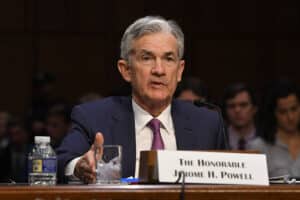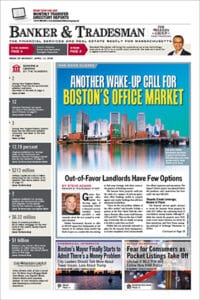
Federal Reserve Chairman Jerome Powell testifies to Congress in 2018. Photo courtesy of the Federal Reserve
The Federal Reserve unleashed its boldest effort yet to protect the U.S. economy from the coronavirus on Monday, moving to help companies and governments pay their bills and survive a devastating crisis.
With lending in Treasury and mortgage markets threatening to shut down, the Fed announced an aggressive set of programs Monday to try to smooth out those markets. To do so, it committed to buy as much government-backed debt as it deems necessary. And for the first time ever, the Fed said it plans to buy corporate debt, too.
Its intervention is intended to ensure that households, companies, banks and governments can get the loans they need at a time when their own revenue is fast drying up as the economy stalls.
The Fed’s all-out effort to support the flow of credit through an economy ravaged by the viral outbreak has now gone beyond even the extraordinary drive it made to rescue the economy from the 2008 financial crisis.
“The coronavirus pandemic is causing tremendous hardship across the United States and around the world,” the Fed said in a statement. “Aggressive efforts must be taken across the public and private sectors to limit the losses to jobs and incomes and to promote a swift recovery once the disruptions abate.”
Move Pressures Congress
The announcement initially lifted stocks in early trading. But rancorous talks in Congress over a $2 trillion rescue package – and uncertainty over when any agreement might be reached – depressed shares about 2.5 percent in volatile midday trading. The yield on the 10-year Treasury bond fell, a sign that more investors are willing to purchase the securities.
With its new programs, the Fed, led by Chair Jerome Powell, is trying to both stabilize the economy and allay panic in financial markets. As the need for cash has escalated among many corporations and city and state governments, large businesses have been drawing as much as they can on their existing borrowing relationships with banks.
The intensifying need for money means that banks and other investors are seeking to rapidly unload Treasuries, short-term corporate debt, municipal bonds and other securities. The Fed’s move to intervene as a buyer of last resort is intended to supply that needed cash.
Many economists say that whatever financial support Congress eventually provides will likely be even more important than the Fed’s intervention. And they warn that such fiscal help needs to come soon.
The Fed’s intervention is not a substitute for fiscal stimulus,” said Joseph Gagnon, a former Fed economist who is now senior fellow at the Peterson Institute for International Economics. “Let’s hope Congress passes something quickly.”
Joe Brusuelas, chief economist at RSM, a tax and advisory firm, said that if Congress can pass the legislation and have it signed into law by Tuesday, banks could start making loans to small and medium-sized businesses, with the Fed’s support, by Friday.
$300B in Bonds, $200B in MBS
In its announcement Monday, the Fed said it will establish three new lending facilities that will provide up to $300 billion by purchasing corporate bonds, a wider range of municipal bonds and securities tied to such debt as auto and real estate loans. It will also buy an unlimited amount of Treasury bonds and mortgage-backed securities to try to hold down borrowing rates and ensure those markets function smoothly.
The central bank’s go-for-broke approach is an acknowledgment that its previous plans to keep credit flowing smoothly, which included dollar limits, wouldn’t be enough in the face of the viral outbreak, which has brought the U.S. economy to a near-standstill as workers and consumers stay home. Last week, it said it would buy $500 billion of Treasuries and $200 billion of mortgage-backed securities, then quickly ran through roughly half those amounts by week’s end.
And on Monday, the New York Federal Reserve said it would buy $75 billion of Treasuries and $50 billion of mortgage-backed securities each day this week.
The move came as the Federal Housing Finance Agency announced it had authorized Fannie Mae and Freddie Mac to provide mortgage-backed securities investors with additional short-term financing of their positions, called “dollar roll transactions,” providing liquidity to these investors in exchange for FHFA mortgage-backed securities.
Next Quarters ‘Probably Bad’
“They’re really setting the economy up” to start functioning again when the health crisis subsides, said Donald Kohn, a former Fed vice chair who is a senior fellow at the Brookings Institution. “Part of this is about the other side of the valley: Make sure the credit is there.’’
Kohn noted that it would take time to set up some of the Fed’s programs, but just knowing that they are on the way should reassure businesses.
Roberto Perli, a former Fed economist who is now head of global policy research at Cornerstone Macro, cautioned that the benefits won’t be felt immediately.
“The next couple of quarters will still be probably bad,” he said.
The new programs announced Monday by the Fed include two that will buy corporate debt issued by large companies.
UPDATED 9:47 a.m., March 24, 2020: This story has been updated to include actions by the Federal Housing Finance Agency






